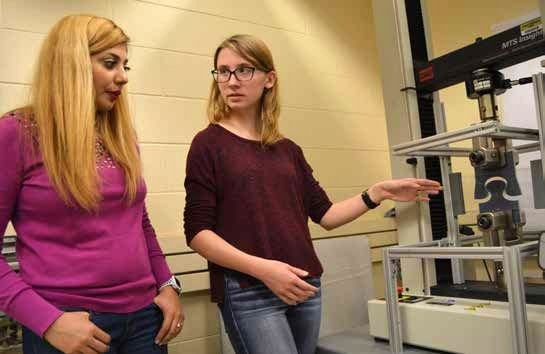Ironclad Insights
Diabolical beetle's super strength may hold secrets to improving machinery, materials
Getting run over by a car is not a near-death experience for the diabolical ironclad beetle.
How the beetle survives could inspire the development of new material joints with the same herculean toughness, said Pablo Zavattieri, the Jerry M. and Lynda T. Engelhardt Professor in Civil Engineering. These joints or connections would be strong but ductile like a paper clip, making structures that employ dissimilar materials safer and longer-lasting.
The study, led by engineers at Purdue University and the University of California, Irvine (UCI), found that the diabolical ironclad beetle’s super-toughness lies in its two armor-like “elytron” that meet at a line, called a suture, running the length of the abdomen. In flying beetles, the elytra protect wings and facilitate flight.
But the diabolical ironclad beetle, a terrestrial beetle, doesn’t have wings. Instead, the elytra and connective suture help to distribute an applied force more evenly throughout its body.
“The suture acts like a jigsaw puzzle,” Zavattieri said. “It connects various exoskeletal blades — puzzle pieces — in the abdomen under the elytra.”
Zavattieri has been putting this puzzle together for more than four years now and has teamed up with graduate and undergraduate students in the Lyles School of Civil Engineering to assist him in his research. One such undergrad was Molly Cooper (BSCE ’19).

Post-doctoral researcher Maryam Hosseini and undergraduate Molly Cooper test the strength of the beetle-inspired material.
“These are beetles that can be run over by cars and come out alive,” Cooper said. “It seemed like a great sample to study and see if we could recreate that strength. And when we recreated the pattern with 3D printing, the material was many times stronger than it had been before.”
To uncover these strategies, a team led by UCI professor David Kisailus first tested the limits of the beetle’s exoskeleton and characterized the various structural components involved by looking at CT scans.
Using compressive steel plates, UCI researchers found that the diabolical ironclad beetle can take on an applied force of about 150 newtons — a load of at least 39,000 times its body weight — before the exoskeleton begins to fracture.
That’s more impressive than it sounds. A car tire would apply a force of about 100 newtons if running over the beetle on a dirt surface, the researchers estimate. Other terrestrial beetles the team tested couldn’t handle even half the force that a diabolical ironclad beetle can withstand.
Zavattieri’s lab followed up these experiments with extensive computer simulations and 3D-printed models that isolated certain architectural features of the suture to better understand their role in saving the beetle’s life.
All of these studies revealed that when under a compressive load such as a car tire, the diabolical ironclad beetle’s jigsaw-like suture offers two lines of defense.
First, the interconnecting blades lock to prevent themselves from pulling out of the suture like puzzle pieces. Second, the suture and blades delaminate, which leads to a more graceful deformation that mitigates catastrophic failure of the exoskeleton. Each strategy dissipates energy to circumvent a fatal impact at the neck, where the beetle’s exoskeleton is most likely to fracture.
Even if a maximum force is applied to the beetle’s exoskeleton, delamination allows the interconnecting blades to pull out from the suture more gently. If the blades were to interlock too much or too little, the sudden release of energy would cause the beetle’s neck to snap.
It’s not yet known if the diabolical ironclad beetle has a way to heal itself after surviving a car “accident.” But knowing about these strategies could already solve fatigue problems in various kinds of materials and structures.
“An active engineering challenge is joining together different materials without limiting their ability to support loads. The diabolical ironclad beetle has strategies to circumvent these limitations,” said David Restrepo, an assistant professor at the University of Texas at San Antonio who worked on this project as a postdoctoral researcher in Zavattieri’s group.
In gas turbines or body panels of lightweight vehicles like cars or aircrafts, for example, metals and composite materials are joined together with a mechanical fastener. This fastener adds weight and introduces stress that could lead to fractures and corrosion.
“These fasteners ultimately decrease the performance of the system and need to be replaced every so often. But the interfacial sutures of the diabolical ironclad beetle provide a robust and more predictable failure that could help solve these problems,” said Maryam Hosseini, who worked on this project as a PhD student and postdoctoral researcher in Zavattieri’s group. Hosseini is now an engineering manager at Procter & Gamble.
UCI researchers built a carbon fiber composite fastener mimicking a diabolical ironclad beetle’s suture. Purdue researchers found through loading tests that this fastener is just as strong as a standard aerospace fastener, but significantly tougher.
“This work shows that we may be able to shift from using strong, brittle materials to ones that can be both strong and tough by dissipating energy as they break. That’s what nature has enabled the diabolical ironclad beetle to do,” Zavattieri said.
This research is financially supported by the Air Force Office of Scientific Research and the Army Research Office through the Multi-University Research Initiative (award number FA9550-15-1-0009). The study used resources at the Advanced Light Source, a U.S. Department of Energy Office of Science User Facility.
A video explaining these findings is available on YouTube.

